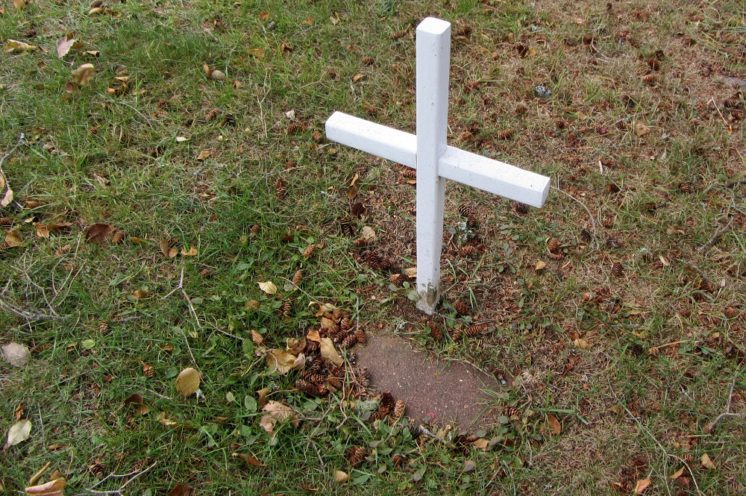Lizzie Naganab’s Glowing Grave
I’m not sure how I acquired the book, but there it sat, on the passenger seat of my car as I drove up Reservation Road northwest of Cloquet. There are some things you wish you could unsee — because a history buff like me wants all the facts. Alas, those facts can be elusive, especially so many years from an event. This was the case with a strange little entry in Six Feet Under: A Graveyard Guide to Minnesota.
I’m not into the morbid route to history that this little guide offers. That was my mother. She had dozens of books along the lines of “Wisconsin Death Trip,” “Hollywood Book of the Dead” or “Myths and Mysteries: Strange Stories of the Dead” on her shelves. Morbidly, she died earlier this year and perhaps that is how this book floated into my stacks. She redeemed herself in recent years by ditching the stories of others and digging into her own family history, a genealogy I greatly appreciate today.
Here is the entry, factual errors and all, that I found in the Minnesota book, which I will correct as this story continues.
Lizzie Naganub
Died October 1931, aged 82
Holy Family cemeteries, Fond du Lac Reservation, west of Cloquet, Carlton County; unmarked graveDaughter of Joseph Naganub, Lizzie Naganub was described as a “witch woman” on the White Earth Indian Reservation. She was buried in Holy Family cemeteries … on October 7, 1931. … Newspapers reported that a fiery ball (also described as an “apparition taking the form of an intermittent light”) haunted her grave, bringing nightly visitors to the cemetery. The scientific explanation for the phenomenon was that such a light, often called will-o’-the-wisp, was caused by bog gas. Some tribal members insisted that it was the result of Naganub being poisoned by a medicine man “whose powers were stronger than hers” and that the fireball was a “sort of proof to the tribesman that the woman was a victim of such poison.”
Family history may have played a large role in the interest over Lizzie’s gravesite. Here is the background, from the 2015 publication of An Ethnographic Study of Indigenous Contributions to the City of Duluth.
Chief Naganab was born in 1795 and later became chief of the Fond du Lac band of Lake Superior Chippewa. He originally lived along the St. Louis River in the Fond du Lac area of Duluth. He later moved to the Fond du Lac Indian Reservation after he signed the 1854 Treaty with the Chippewa. Naganab was so famous that his obituary appeared on the front page of the New York Times on June 8, 1894. The Times called Naganab a “Venerable Chippewa Chief.” His signing of the 1826 Treaty was credited for the development of the cities of Duluth and Superior. Chief Naganab’s daughter, Lizzie, also became famous after her death, in October of 1931. Her ghost was reportedly seen by thousands of people, including police officers and newspaper reporters in the Holy Family Cemetery on the Fond du Lac Reservation. The story repeatedly made headlines in Duluth as well as all across the nation.
Yeah, I couldn’t let this strange story go without further examination; which is why I eventually found myself driving in the dead of night last week on a lonely road under a waxing harvest moon that was soon to be lost under clouds and drizzle.
It was dark at Holy Family cemetery. It was confusing. As is tradition in warding off spirits, Native burial grounds are awash with solar lights and pinwheels and other decorations not usually seen in the mostly Anglo versions in the region. And grave markers here can be small unmarked slabs level to the ground, a canoe paddle, a bordered and decorated rectangle, handmade crosses, a wooden “grave house” or “spirit house,” and the more familiar upright stone marker.
It is a site to behold. The constant thought here is how well-regarded these departed are. You can see it in the effort the living are putting into the grave markers. And people visit. There are benches, camp and lawn chairs for those paying respects.
I stood still in the darkness. The cemeteries at Holy Family are downright nerve-wracking to the unaccustomed with the whirs and whaps. I didn’t know why I had ventured here in the dark. Perhaps to just get a sense of what people may have experienced 87 years ago when I wouldn’t have been so lonely out there. As many as 1,000 people would dumbly look over the cemetery nightly then, just as I was now.
I didn’t see any apparitions, glows or any thing out of ordinary. But the story of Lizzie Naganab’s grave lights isn’t something made up out of the blue. It actually happened. Reservation residents, police officers, clergy and other “respected” people from the community all reported that something was happening at the cemetery in October of 1931.
I scoured newspaper archives, including a collection gathered by Christine Carlson in 2013 and printed in the Fond du Lac reservation newspaper. I was able to piece together the events that occurred around Lizzie’s death on Oct. 5, 1931.

The Pine Knot was the newspaper in Cloquet at the time of the strange cemetery lights in October of 1931.
Lizzie Naganab was born on the reservation in 1862 and was the likely granddaughter of the first Chief Joseph Naganab. The lineage isn’t very clear, and it’s confusing, since Chief Joseph had a son who was also known by that honorific. If Lizzie was the first chief’s daughter, she would have been born when he was in his late 60s.
According to a death certificate found by Carlson, Lizzie was a housewife and died from heart trouble at age 69. There are no contemporary accounts of her being a “medicine woman” save for mangled newspaper accounts at the height of the cemetery hysteria that included the clichéd term “Indian princess.” There is also no information on any connection to White Earth, as Six Feet Under suggests.
Today, you’ll find the name spelled Nahgahnab.
The night after Lizzie was buried on Oct. 7, in what was then called the “new” cemetery near the Holy Family Mission church, brothers Louis and John LaPrairie witnessed a reddish light, 8 to 10 inches in diameter, near the new grave. They lived near the cemetery and said the light was bright enough to light up other graves in a radius of 100 feet.
Word eventually spread about the light. Some rez residents, fearing an evil spirit, shot at the light. A local police officer vouched for the presence of the light, some nights showing up as two orbs hovering over the cemetery.
When the light would appear, some of the native men who were ready to shoot at it became frozen in awe or fear, according to one reporter, leaving it to local white men to take aim.
“We are reliably informed that three prominent young men of the city,” the Cloquet Pine Knot reported, “to wit: Clifford ‘Tippy’ Bertram, a one-time special police; Clarence ‘Dutch’ Ehrman, member of the state motor patrol; and Ervin ‘Coon’ Adamschek [a local police officer] fired shots at the phenomena. The young men, along with many others, avow the actual existence of the strange sight.”
As more white people came to inspect and vouch for the light, word quickly spread throughout the Cloquet area and soon hordes of people were clamoring to see the light for themselves.
That hysteria, and the presence of gullible and culturally illiterate newspaper reporters from beyond Cloquet, brought out wild stories from reservation people, who seemingly riffed on the obvious cartoonish lens the outsiders had on the culture.
Newspaper reports were picked up on the Associated Press and United Press wire services and the Cloquet dateline was splashed in papers across the country.

News of the strange lights spread on news wires across the country, including this entry from the L.A. Times.
There was at least one instance of media pushback, according to a wire story with no byline. The presence of “Black Ralph” Greenfield, a photographer, and an “unscrupulous newspaper man from Superior,” brought several men to oust the two from the cemetery and seize the camera, which was eventually returned.
At other times, John LaPrairie seemed to delight in taking reporters to see the light. A News Tribune reporter said LaPrairie grabbed his arm as the light appeared and said “Look! There it is!”
The crowds and cars became so numerous on the narrow and rutted road that deputies had to be brought in to direct traffic. There were, at the height of interest, 500 cars coming in from dusk to after midnight. Enterprising residents started charging for parking in fields, 25 cents to $1 depending on how close one wanted to be, and even set up a hot dog and coffee stand. It was said the money would go into making improvements to a road that had long been a bane to travelers.
The curious were admonished for tramping over the cemetery ground, breaking crosses and generally disrespecting the resting places for the dead. Local residents set up guard duty to keep people out of the cemetery. The gawkers didn’t seem to mind since one could easily see the dancing light from a nearby hill.
Experts from universities came to try and explain away the light as a natural occurrence given the swampy conditions nearby. At least one spiritualist came and said the “ectoplasm” was indeed curious and not anything to do with “swamp gas.”
The Holy Family priest, Father Thomas Borgeden, was also a witness to the light, and provided the most sober commentary after holding a service in the small church as hundreds gathered outside. “I have formed no opinion on the apparition,” he said. “I cannot say it is something supernatural and I have no reason to say it is a natural phenomenon. All I can say is that I have seen it.”
Father Thomas had “lived among the Indians of Minnesota as a missionary for 40 years,” the News Tribune reported. “I don’t believe in ghosts,” he said. “I do believe in supernatural manifestations. The Indians have told me many strange incidents, some similar to the appearance of the ball of flame which flutters over the cemetery.”
He described the light as akin to seeing a kerosene lamp, about 15 feet above the ground and “jumping sideways from 10 to 20 rods.”
I talked to Jeff Savage at the Fond du Lac Reservation Cultural Center & Museum, who had a readily available clipping about the Lizzie light from the Pine Knot newspaper. I asked him who may have been zooming who when it came to the light. “Welcome to the Rez,” was Savage’s quick answer.
Some of the locals said the light was a sign of Lizzie being poisoned and shooting at the light to destroy it would bring on the death of the guilty party in four days. Some reported the sound of a baby wailing after each gunshot at the light.
Still others, without any hard evidence, said the whole thing was a ruse by the LaPrairies and others.
Savage said the story is known in reservation history, but the details are murky. “It’s been passed down,” he said, but the veracity and cultural impact is likely lost to past generations. He referred me to some elders who meet as a “historical society” but I found no firm connection to an event that happened now 87 years ago.
Some cemetery experts at the reservation main office said the nomenclature for the cemetery has changed over the years, making it difficult to discern where Lizzie’s unmarked grave is located. There are three distinct cemetery plots there. The “new” cemetery today is the one right next to the church. In 1931, the “new” cemetery may have been the small one across the Fond du Lac Creek that empties into the nearby St. Louis River. On higher ground from there is a much larger plot and the marker for Chief Joseph.
That middle cemetery is near some low ground, which may make sense as Lizzie’s burial site since so many attributed the light around her grave to “swamp gas,” or the glow from decaying organic material, known and “foxfire” or “will-o’-the-wisp.”
After nearly two weeks of frenzy at the cemetery, things seemed to die down by the end of the month. The light or lights were appearing less frequently. The reporters were gone, but that was likely due to two national stories that dominated newspaper space: Thomas Edison died and Al Capone was found guilty of tax evasion. The intriguing story from a sparsely populated reservation in northern Minnesota was gone from the news cycle.
The only mention found after that two-week period came in a Minneapolis paper in early November. Charles Morrow, the spiritualist from Minneapolis who visited the cemetery, was now giving talks at Twin Cities area churches about the “Lights of Cloquet.”
The mystery of Lizzie Naganab and the lights remains mostly that. It proves the bane of digging for history, sorting the chaff, and coming to some grips with not ever really knowing the hard facts.
Perhaps it’s enough to just sit in the dark there at Holy Family, trying to imagine the scene from so long ago and, upon returning in daylight hours later, simply admiring the living remembrances of the graves today.
And perhaps, after this telling, some of those in the know will let us all know.

Christine Carlson collected some information on the Lizzie Naganab phenomenon for the Fond du Lac newspaper in October 2013.
Recommended Links:
Leave a Comment
Only registered members can post a comment , Login / Register Here




















1 Comment
Helmut Flaag
about 6 years ago